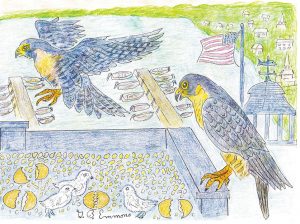This species of falcon follows the coastal shoreline of both North and South America, and the name ‘peregrine’ actually means ‘wanderer.’
After nesting on edges of rocky cliffs and edges of high buildings, as in my illustration of Mattapoisett Harbor (some credit goes to Chris Mellow for aid in the Mattapoisett Harbor scene), the peregrine falcon takes wing to wander and earn its reputation as one of the most widely distributed species of the raptor travelers all over the world.
To Buzzards Bay bird watchers, it is a spectacular high-flying aerial performer, diving down to catch waterfowl – such as the bufflehead ducks in my previous article – along mud flats at the water’s edge.
The name ‘falcon’ is derived from the Latin translation terminology of ‘falco,’ describing the flight profile of sweptback wings. The wings are held back from the body in flight, a position known as a ‘swoop,’ to attain recorded diving speeds of over 200 miles per hour.
As in the axiom “speed kills,” prey is slain from a jolting sudden blow of the elongated main talon held close to the peregrine’s body. It has a sudden impact like the clenched fist of a prizefighter.
This falcon also has an elongated razor-sharp extension of the upper beak, which is classified as a ‘tomial tooth’ for fitting around the neck of a victim to sever the head. This feature is thought to be an evolutionary leftover feature dating back to prehistoric ancestry of birds from reptiles.
Like all avian raptors, a falcon has extraordinary perception of sight and awareness of prey. It soars on thermals high overhead to attain height to pause like a hovercraft for a broad vantage point of wide observation and prey recognition. The black feathers that cover its head act like the mantle of a hood for protection against the glint of the sun.
The depth of color of this falcon is a good barometer of adaptability to locality of its habitat. The darkness around the eyes also facilitates visibility in ultraviolet light, a perception ability not shared with most other mortals.
The historic practice of falconry goes back at least a thousand years to the medieval art of training raptors to hunt in cooperation with humans. They often rode on horseback to keep up with the fast-moving aerial chase. Even today, falconers favor the peregrine as a symbol of prowess and proficiency. It has earned the reputation of foremost scepter of authority in his aerial kingdom. However, as a domestic homemaker, it is quite different.
This all takes shape with domestic displays of courtship, like its high circling flight by the male, with spectacular dives and chases by both sexes. Then it is said they mate for life. They do not build nests, but often merely scrape out a shallow surface on the edge of a rooftop to lay three or four brownish eggs for white, buff-colored chicks to hatch in a month.
Soon after the young leave the nest after they become fledglings, adults feel free to resume their own wandering ways. Travel distance and direction is drawn by the availability of food, particularly pigeons in urban areas, and shorebirds like loons, geese, gulls, and small mammals.
Peregrines have spread to no less than six continents all over the Earthy planet, particularly here since the ban of pesticides. I would, in conclusion for you as a bird watcher, present a mythological image of the falcon, not unlike a phoenix, soaring up of the ashes of wilderness desecration on wings of environmental awareness and appreciation.
By George B. Emmons
